

The U.S. high school graduation rate rose last year, a sign education systems across the country are finding greater success in preparing children for the future. Finishing school is just one indication of the quality of a child’s upbringing. Early education, health, and safety are crucial to providing children with the best chance to become healthy, productive adults.
When choosing where to raise their children, parents look at factors like these. However, some parts of the country struggle to provide a good environment for childhood development. Children in areas with high crime rates, low graduation rates, and low preschool enrollment rates are more likely to struggle later in life in their work and health.
24/7 Wall St. reviewed a number of educational, health, and safety measures to determine the worst cities to raise children in the United States. Our index included preschool enrollment figures and high school graduation rates, which each are meant to serve as a proxy for the quality of education in the area. Also included in the index were access to areas for physical activity, as well as violent crime rates.
While measures of income were not part of our index, many of the worst cities to raise children have low incomes, a factor which often corresponds with the factors we measured, such as violent crime and poor educational outcomes.
Two parts of the U.S. have a much greater share of struggling metro areas. Nine of the 25 worst places to raise a kid are located in the west, in states like California, New Mexico, and Oregon. Fourteen of those areas are spread out among the South. The remaining two metro areas, Danville, Illinois and Battle Creek, Michigan, are in the Midwest. Four California cities are among the worst to raise children, a larger number than any other state.
Click here to see the worst cities to raise children.
Click here to see our detailed findings and methodology.
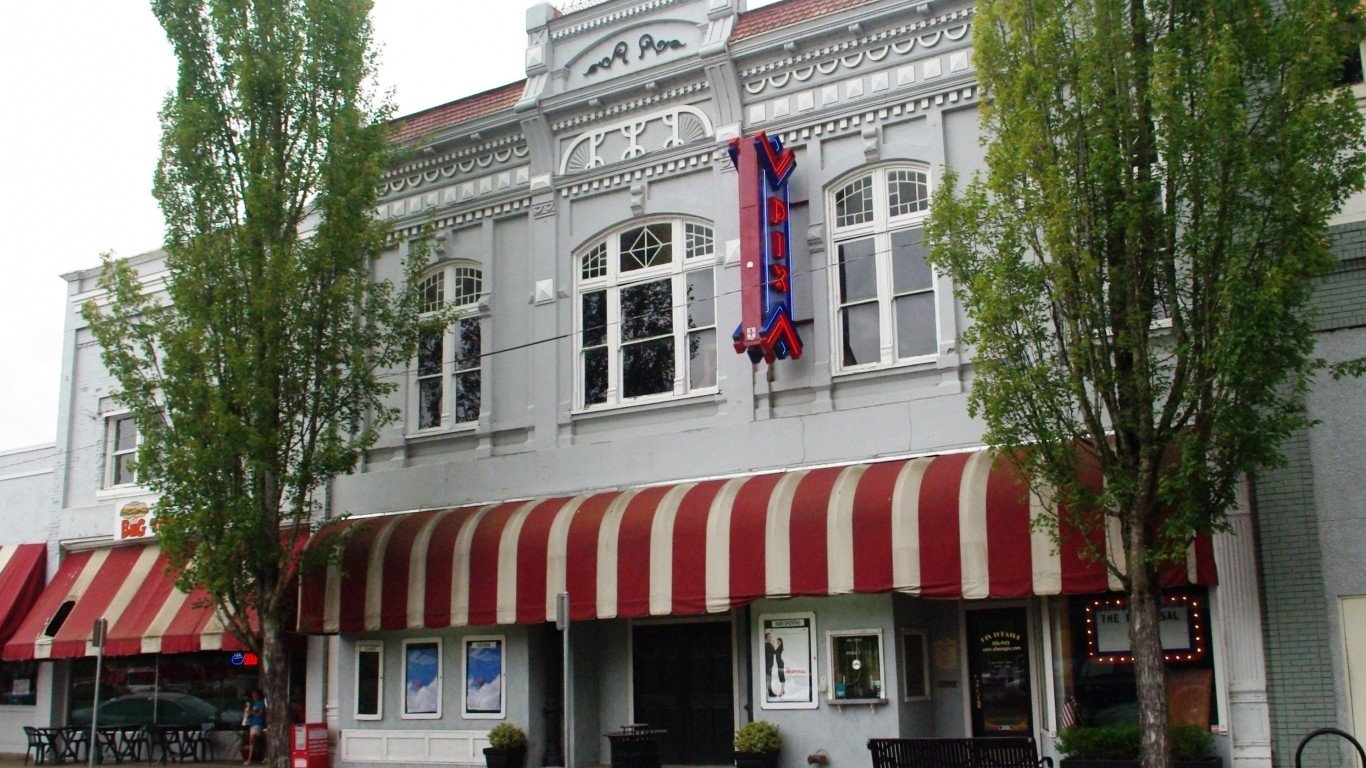
25. Albany, OR
> Preschool enrollment: 24.6% (lowest 10%)
> High school graduation rate: 70.9% (lowest 10%)
> Pop. with access to areas for exercise: 68.1% (lowest 20%)
> Violent crime rate: 113.9 per 100,000 (lowest 10%)
Children in Albany, Oregon, are among the most likely in the country to both enroll in school later and fail to complete their education on time. Less than a quarter of children age 3 and 4 are enrolled in preschool, one of the lowest preschool enrollment rates in the country. A study published in the American Psychological Association found that attending preschool can increase academic preparedness in children and help cognitive development. Studies have also shown that children who go to preschool are more likely to graduate from high school. Albany’s high school graduation rate of 70.9% is the 10th lowest among U.S. metropolitan areas.
[in-text-ad]

24. Sebring, FL
> Preschool enrollment: 36.3%
> High school graduation rate: 64.0% (lowest 10%)
> Pop. with access to areas for exercise: 80.9%
> Violent crime rate: 327.5 per 100,000
Sebring, Florida appears to have one of the least effective education systems of any U.S. metro area. Only an estimated 64.0% of area high school students receive a diploma within four years. No other metro area in the United States had a lower graduation rate. In addition to being a sign of a suboptimal education system, this low graduation rate may also be at least partially due to the economic struggles of residents in the metro area. An estimated 33.6% of the area’s children live below the national poverty level. Studies have shown that children in low income households are more likely to struggle in school. One report found children in low income households are 15.6% less likely to graduate from high school than other students.

23. Myrtle Beach-Conway-North Myrtle Beach, SC-NC
> Preschool enrollment: 45.1%
> High school graduation rate: 71.1% (lowest 10%)
> Pop. with access to areas for exercise: 65.2% (lowest 20%)
> Violent crime rate: 460.7 per 100,000
The Myrtle Beach-Conway-North Myrtle Beach metro area, which straddles the North Carolina and South Carolina border, struggles with many key issues that make it a difficult place to raise children. The high school graduation rate of 71.1% is one of the lowest in the country. Across all metro areas, the graduation rate averaged 84.1%. It may be also more difficult for children in the area to find a place to get physical activity. Just 65.2% of the area population reported having access to a place for exercise. The national share is 83.0%. Lacking a place to exercise can be detrimental to a child’s development, as children who regularly exercise are less likely to develop health issues such as obesity, high blood pressure, and diabetes.

22. Stockton-Lodi, CA
> Preschool enrollment: 36.1% (lowest 20%)
> High school graduation rate: 82.3%
> Pop. with access to areas for exercise: 73.0%
> Violent crime rate: 823.6 per 100,000 (highest 10%)
In the Stockton-Lodi metro area, just 36.1% of children age 3 or 4 are getting early education before kindergarten, among the lower preschool enrollment rates of U.S. cities. Lacking early education can leave children behind their peers when it comes to educational and emotional development. With an annual violent crime rate of 824 incidents reported per 100,000 residents, the area is one of the most dangerous in the country. The high school graduation rate of 82.3% is among the lower rates of U.S. metro areas and slightly below the average rate of 84.1% among metro areas.
Adults in the area are among the least educated in the country. Just 77.1% of Stockton-Lodi adults graduated from high school, one of the lowest rates among U.S. metro areas. Studies show that children in households where parents have lower educational attainment are more likely to struggle in school.
[in-text-ad-2]

21. Pine Bluff, AR
> Preschool enrollment: 59.9% (highest 10%)
> High school graduation rate: 83.8%
> Pop. with access to areas for exercise: 48.1% (lowest 10%)
> Violent crime rate: 909.1 per 100,000 (highest 10%)
The violent crime rate in the Pine Bluff, Arkansas, metro area is one of the highest in the country. There are 909 violent crimes — which include homicide, robbery, and aggravated assault — reported annually per every 100,000 residents. According to County Health Rankings & Roadmaps, people living in high-crime areas — both adults and children — experience greater stress levels. They also may be deterred from healthy activities like exercise. Just over half of Pine Bluff area residents have no access to a place where they can exercise, one of the lowest rates in the United States.

20. Columbia, SC
> Preschool enrollment: 58.7% (highest 10%)
> High school graduation rate: 71.3% (lowest 10%)
> Pop. with access to areas for exercise: 54.6% (lowest 10%)
> Violent crime rate: 589.5 per 100,000 (highest 20%)
A higher rate of preschool enrollment often correlates with a higher high school graduation rate. The Columbia, South Carolina, metro area is one exception. While Columbia’s preschool enrollment rate of 58.7% is one of the higher such rates among U.S. metro areas, its high school graduation rate of 71.3% is one of the nation’s lowest. Graduation rates can often be affected by a number of factors, including a lack of community engagement or investment in schools and youth programs.
[in-text-ad]
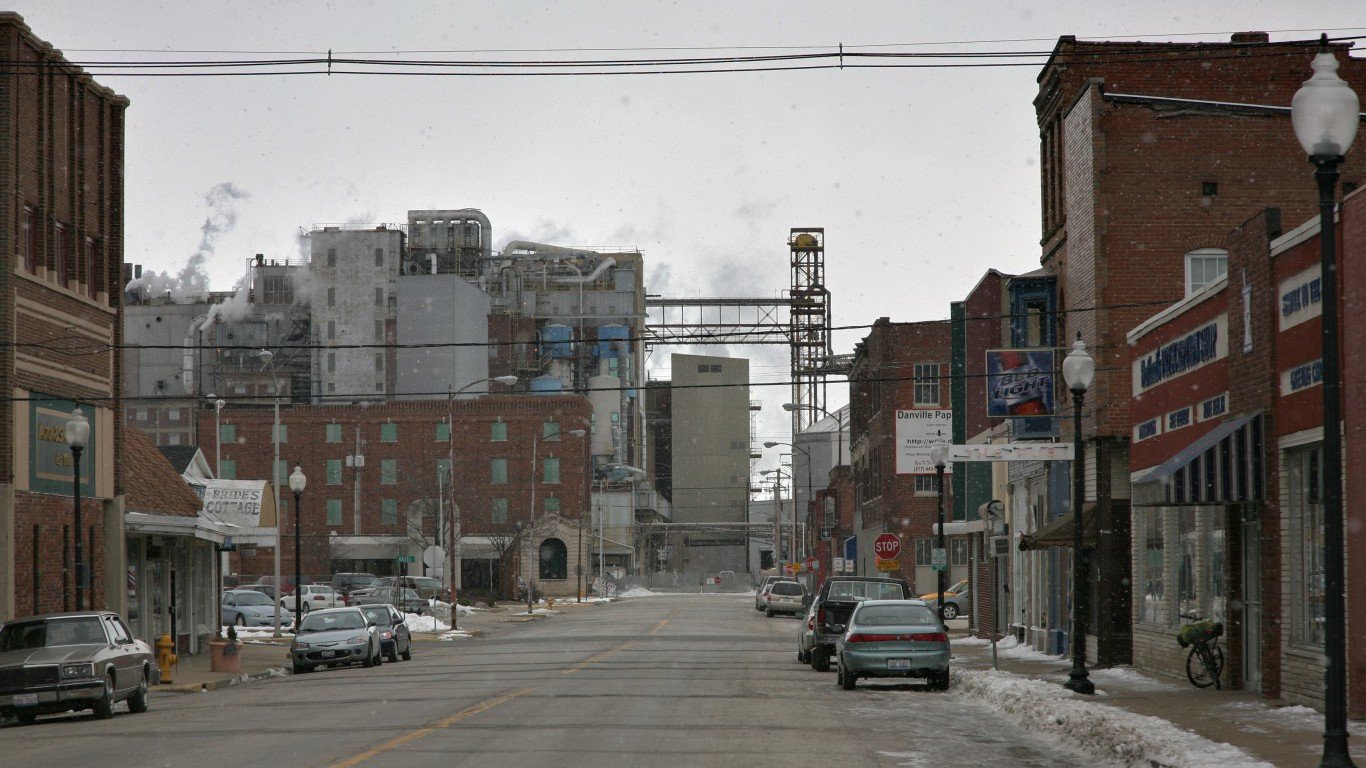
19. Danville, IL
> Preschool enrollment: 39.4%
> High school graduation rate: 78.7% (lowest 20%)
> Pop. with access to areas for exercise: 71.8%
> Violent crime rate: 808.3 per 100,000 (highest 10%)
Danville, Illinois has one of the biggest violent crime problems in the country. Its residents are among the most likely to report an aggravated assault or a burglary of those in any major metropolitan area. There is a proven connection between children who are raised in a high-crime area and stunted learning development. Danville’s high school graduation rate of 78.7% is one of the lower rates among metro areas. Danville also has one of the college attainment rates for adults in the U.S. Only 14.0% of area adults hold at least a bachelor’s degree, less than half the nation’s 31.3% comparable educational attainment rate.

18. Albany, GA
> Preschool enrollment: 43.4%
> High school graduation rate: 80.8%
> Pop. with access to areas for exercise: 58.4% (lowest 10%)
> Violent crime rate: 734.8 per 100,000 (highest 10%)
Albany, Georgia children are some of the most likely to live in poverty among U.S. metro areas. In the country as a whole, the national child poverty rate is 19.5%. In Albany, that child poverty rate is 36.3%. The median annual household income in the area of $40,667 is far below the U.S. median of $57,617. Living in families with financial difficulties makes it more difficult for children to achieve educational success. Some 30% of children who grow up in poverty do not graduate from high school. The Albany area’s high school graduation rate of 80.8% is lower than in most other U.S. cities.

17. Yuba City, CA
> Preschool enrollment: 44.1%
> High school graduation rate: 81.5%
> Pop. with access to areas for exercise: 36.6% (lowest 10%)
> Violent crime rate: 397.5 per 100,000
Studies have shown that the health benefits associated with getting exercise are mental as well as physical. Physical activity can aid in cognitive development in children, but just 36.6% of Yuba City, California, residents have access to a place for physical exercise. Only one other metro area considered has a lower rate of access to exercise amenities. Children are also relatively likely to receive an inadequate education in Yuba City. The area’s preschool enrollment and high school graduation rates are both slightly below U.S. averages.
[in-text-ad-2]

16. Hanford-Corcoran, CA
> Preschool enrollment: 35.2% (lowest 20%)
> High school graduation rate: 83.0%
> Pop. with access to areas for exercise: 44.6% (lowest 10%)
> Violent crime rate: 427.0 per 100,000
Just 35.2% of preschool-aged children in the Hanford-Corcoran area of California are enrolled in preschool, well below the 48.0% of children nationwide. The area’s adult residents have the second lowest rate of higher educational attainment of all metro areas. Only 11.6% have graduated from college — nearly 20 percentage points below the national average. This low level of educational attainment can trickle down to younger generations. Children raised in households where education is a low priority are also less likely to graduate. Hanford-Corcoran residents have little access to exercise. Only 44.6% say they have a place for physical activity. Nationally, 83.0% have access.

15. Florence, SC
> Preschool enrollment: 45.9%
> High school graduation rate: 85.0%
> Pop. with access to areas for exercise: 39.2% (lowest 10%)
> Violent crime rate: 640.6 per 100,000 (highest 20%)
Florence, South Carolina is one of very few U.S. metro areas in which less than 40% of residents said they had a place to get physical activity. Exercise can be crucial for a child’s development and health. Children in high crime areas often have fewer opportunities to go outside to get exercise, and the Florence area also has one of the higher violent crime rates in the country. The area reports a rate of 641 violent crimes per 100,000 residents, compared to a national rate of 386 per 100,000.
[in-text-ad]
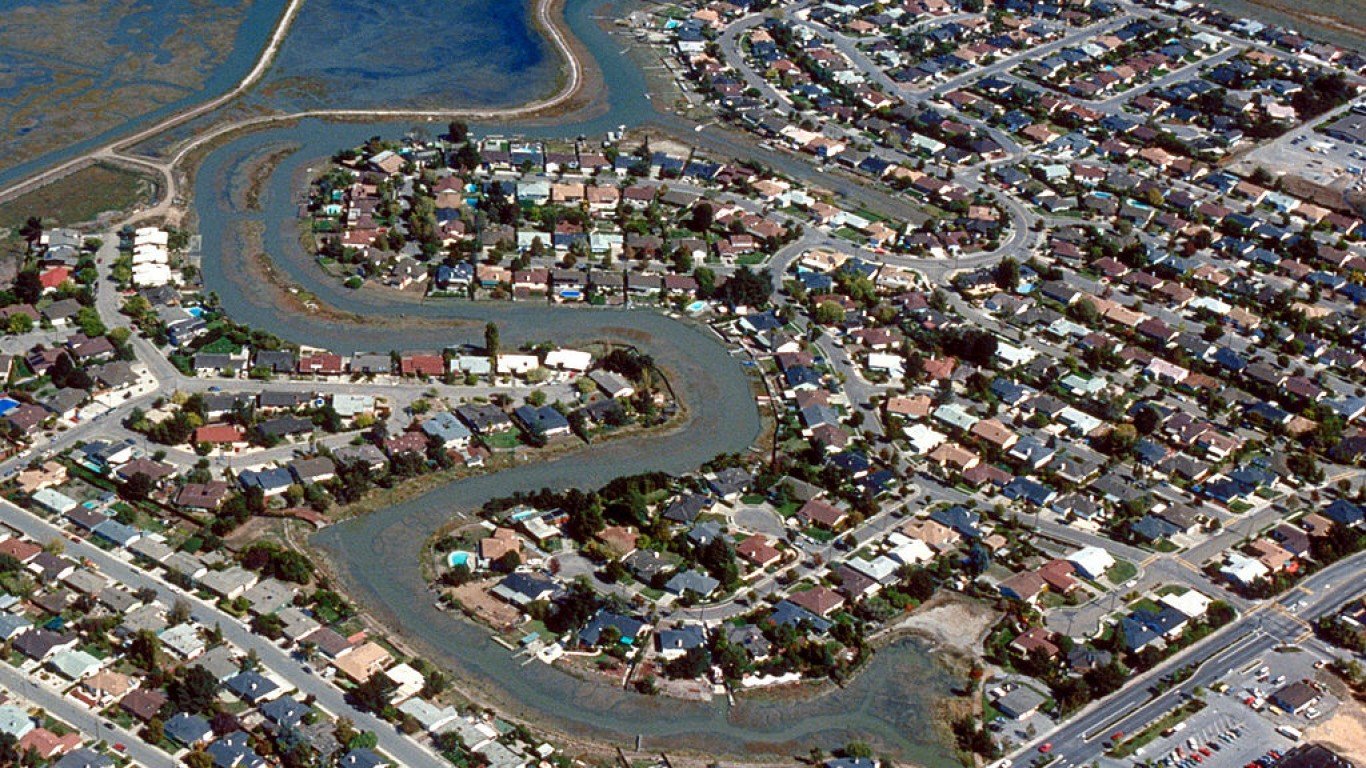
14. Madera, CA
> Preschool enrollment: 18.5% (lowest 10%)
> High school graduation rate: 82.7%
> Pop. with access to areas for exercise: 74.2%
> Violent crime rate: 661.8 per 100,000 (highest 10%)
Approximately 32.4% of children in Madera, California live in poverty, one of the highest shares nationwide, exceeding the national rate of 19.5% of children who are impoverished. The area also has one of the lowest preschool enrollment rates in the nation at just 18.5%. The U.S. average is nearly 30 percentage points higher.

13. Memphis, TN-MS-AR
> Preschool enrollment: 40.3%
> High school graduation rate: 79.6%
> Pop. with access to areas for exercise: 79.2%
> Violent crime rate: 1082.1 per 100,000 (highest 10%)
Living in an area that is prone to violent crime can hinder a child’s sense of well being and emotional development. The Memphis metro area, which extends into three states, is considered one of the worst places to raise a child primarily because of its high violent crime rate. For every 100,000 residents, 1,082 violent crimes were reported. Only two other metro areas had higher rates. Memphis children are also among the most likely to live in families that struggle with financial difficulties. Fewer than 20% of children live in poverty nationwide. In Memphis, the child poverty rate is over 30%.
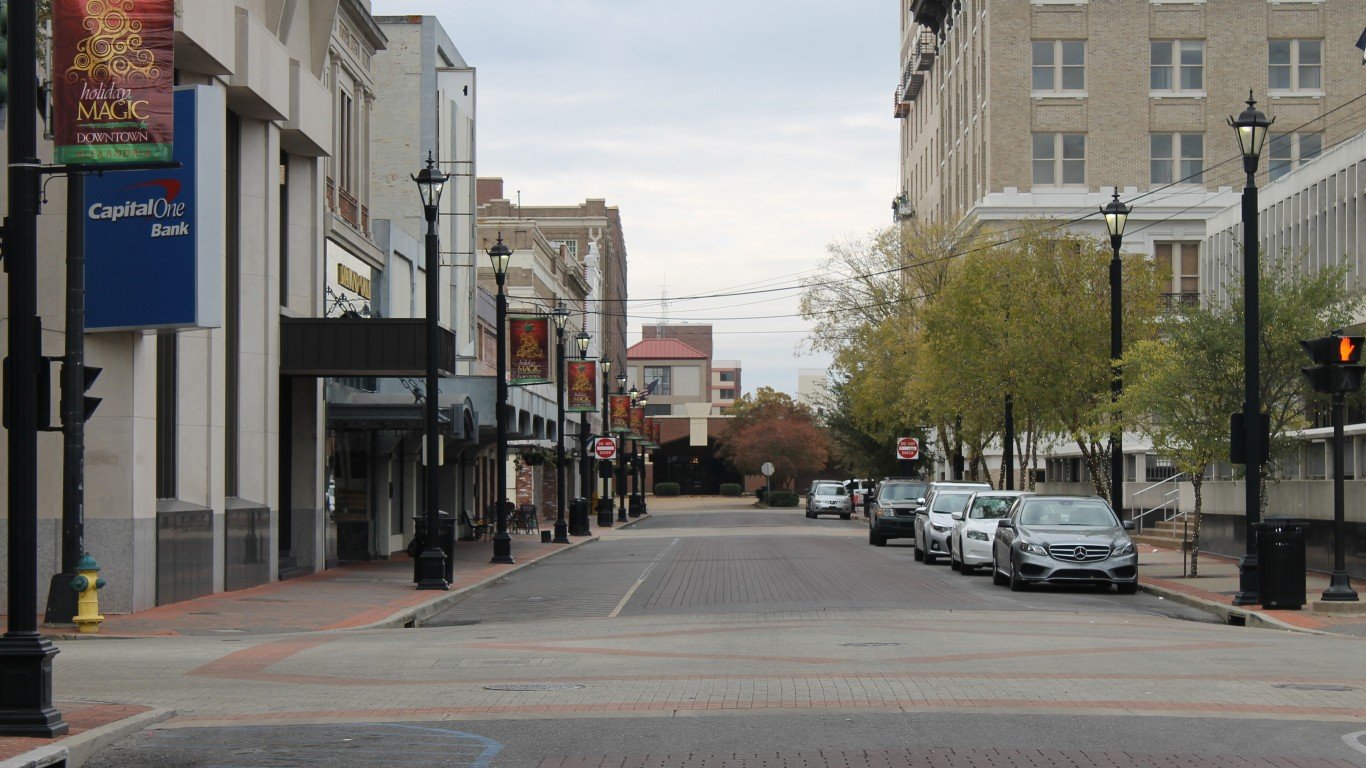
12. Alexandria, LA
> Preschool enrollment: 43.6%
> High school graduation rate: 75.5% (lowest 10%)
> Pop. with access to areas for exercise: 74.3%
> Violent crime rate: 923.2 per 100,000 (highest 10%)
The Alexandria, Louisiana graduation rate of 75.5% is one of the lowest in the country. The average among metro areas is 84.1%. The area’s violent crime rate also makes it a less than ideal place to raise children. Only a handful of metro areas had a higher rate than 923 violent crimes reported per 100,000 residents in the Louisiana metro area.
Babies born to teen mothers are at a greater risk of developing serious health issues, and the Alexandria area has one of the higher teen birth rates in the country. Out of every 1,000 births in Alexandria, 47 are from mothers aged 15-19. The national teen birth rate is 27 per 1,000.
[in-text-ad-2]

11. Odessa, TX
> Preschool enrollment: 35.3% (lowest 20%)
> High school graduation rate: 77.8% (lowest 20%)
> Pop. with access to areas for exercise: 63.8% (lowest 20%)
> Violent crime rate: 713.5 per 100,000 (highest 10%)
Teen pregnancy can cause increased health risks for both the mother and the child when compared to women who are between 19 and 35. Odessa, Texas has the highest teen birth rate in the United States as 76 out of every 1,000 children born are born to teenage mothers. The nationwide average is 27 per 1,000 and the next highest birth rate in the country is just 71 per 1,000. High teen pregnancy in Odessa may be one of the reasons why the graduation rate is among the lowest in the nation. Some 30% of girls who drop out do so because they are pregnant or have a child.
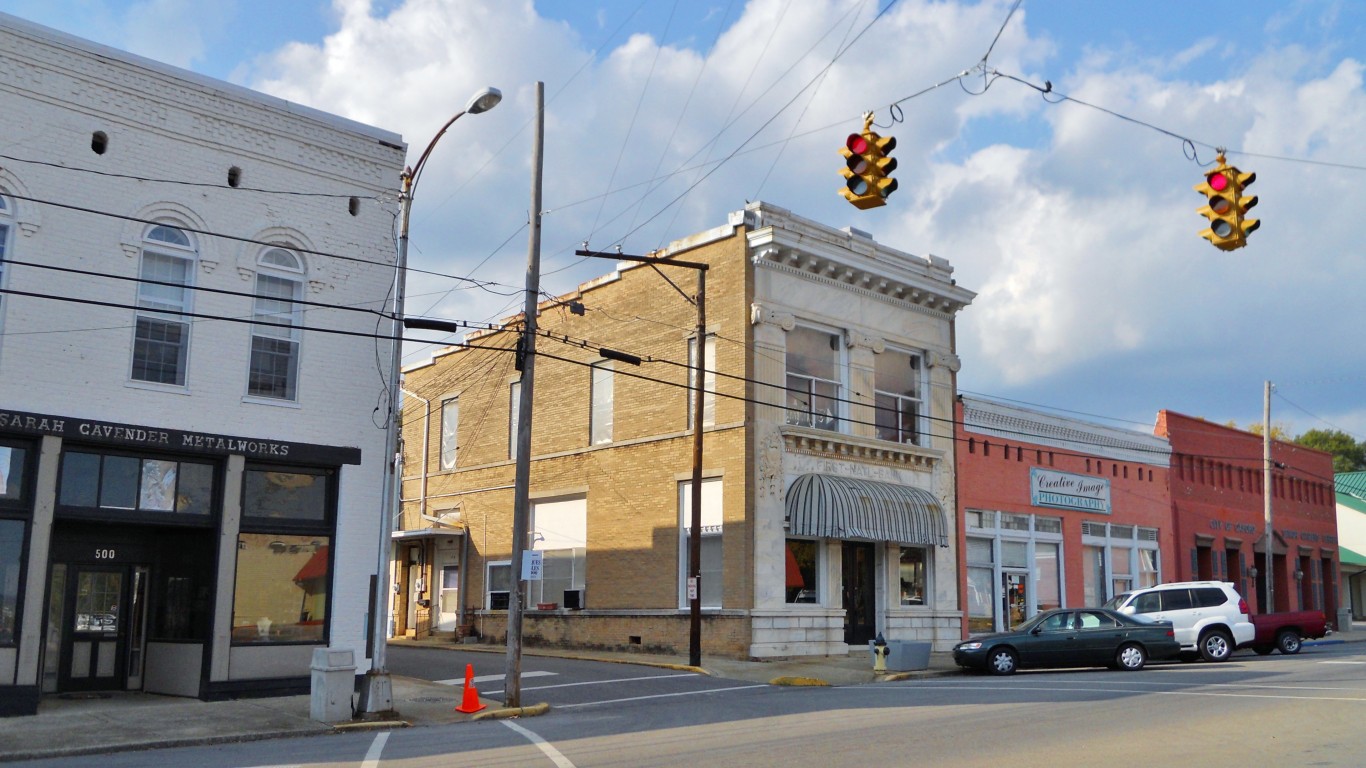
10. Anniston-Oxford-Jacksonville, AL
> Preschool enrollment: 33.2% (lowest 10%)
> High school graduation rate: 92.2% (highest 10%)
> Pop. with access to areas for exercise: 48.2% (lowest 10%)
> Violent crime rate: 894.7 per 100,000 (highest 10%)
Fewer than one third of three- and four-year-olds in the Anniston-Oxford-Jacksonville area of Alabama are enrolled in preschool. Nationwide, that rate is much higher at 48.0%. Violence is also a serious problem in the area, as 895 violent crimes are reported for every 100,000 residents. Despite these challenges, the Anniston area actually has one of the higher graduation rates in the nation. An estimated 92.2% of high school students graduated, one of the best rates in the country.
[in-text-ad]

9. Albuquerque, NM
> Preschool enrollment: 45.7%
> High school graduation rate: 66.1% (lowest 10%)
> Pop. with access to areas for exercise: 84.6%
> Violent crime rate: 901.0 per 100,000 (highest 10%)
In addition to facing risk of direct harm, children living in areas with high violent crime are more likely to experience greater stress levels, which can have an impact on their health. Albuquerque has one of the highest violent crime rates in the nation. There were 901 violent crimes reported for every 100,000 Albuquerque residents. The robbery rate, 239 reported robberies per 100,000 people, is more than double the national rate. Less than two-thirds of Albuquerque students graduate from high school on time. Only two other metro areas have a lower graduation rate.
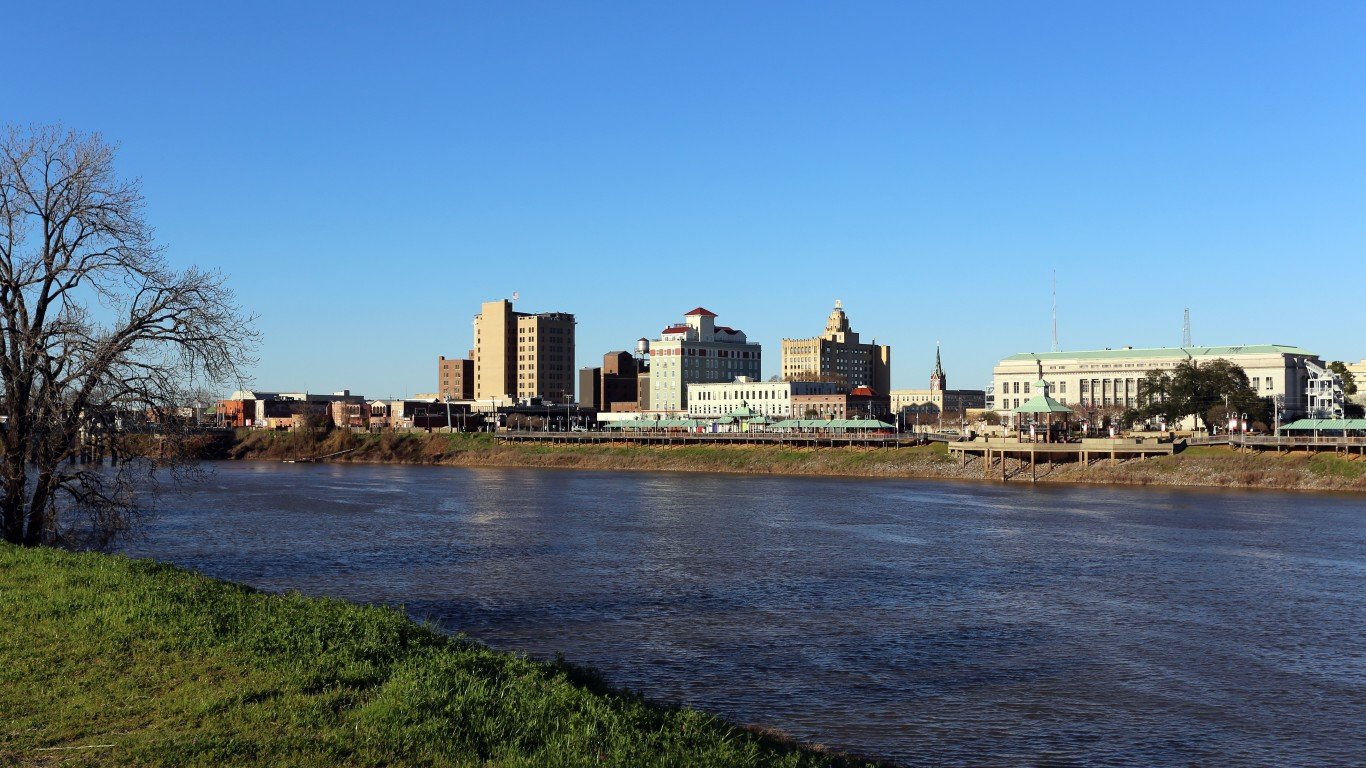
8. Monroe, LA
> Preschool enrollment: 47.6%
> High school graduation rate: 81.2%
> Pop. with access to areas for exercise: 68.8%
> Violent crime rate: 1186.9 per 100,000 (highest 10%)
Monroe, Louisiana is the most dangerous place to raise a child in the U.S. The violent crime rate of 1,187 violent crimes reported per 100,000 residents is the highest of any metro area in the nation. There were 958 aggravated assaults reported for every 100,000 residents in 2016, also the country’s highest rate. The area’s education system also compares poorly to most of the rest of the country. Both Monroe’s preschool enrollment rate and graduation rate are below national averages.

7. Gadsden, AL
> Preschool enrollment: 38.2%
> High school graduation rate: 84.1%
> Pop. with access to areas for exercise: 43.6% (lowest 10%)
> Violent crime rate: 711.9 per 100,000 (highest 10%)
In the Gadsden, Alabama area, just 43.6% of the population has access to somewhere they can get some physical activity. Nationwide, the rate is nearly 40 percentage points higher.
In addition to reporting poor educational outcomes among the area’s children, Gadsden is one of the most violent metro areas in the country. The violent crime rate, which is 712 reported instances per 100,000 residents, is particularly driven by assault. There were 569 aggravated assaults per 100,000 residents reported, which is more than double the national rate. Living in an area with serious violent crime issues can reduce a child’s sense of well being and hinder emotional development.
[in-text-ad-2]

6. Anchorage, AK
> Preschool enrollment: 29.9% (lowest 10%)
> High school graduation rate: 79.4%
> Pop. with access to areas for exercise: 83.9%
> Violent crime rate: 1114.9 per 100,000 (highest 10%)
Anchorage, Alaska is the only metro area among the 25 worst places to raise children in which the median family income is actually above the national average of $71,062. The Anchorage area is actually among the most affluent in the U.S. with an average family income of $95,872.
Yet area children still face many problems that tend to affect low-income places. Anchorage has the second-highest violent crime rate in the country, with 1,115 reported violent crimes per 100,000 residents — close to triple the U.S. rate. Children in the Anchorage area are less likely to receive a complete education as well. The preschool enrollment rate of 29.9% is well below the 48.0% national rate. Anchorage’s high school graduation rate is also below the 84.1% average of all metro areas.
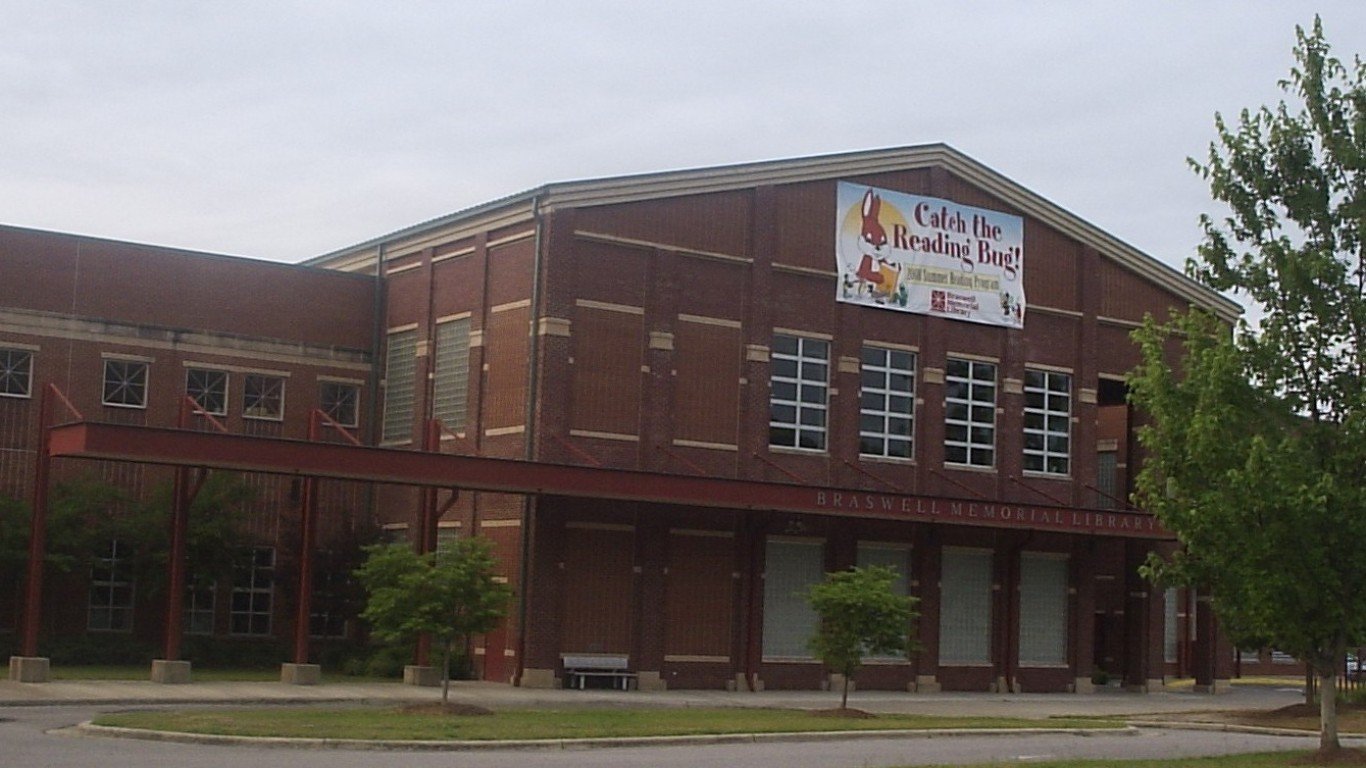
5. Rocky Mount, NC
> Preschool enrollment: 19.6% (lowest 10%)
> High school graduation rate: 81.2%
> Pop. with access to areas for exercise: 51.0% (lowest 10%)
> Violent crime rate: 448.3 per 100,000
The Rocky Mount area has one of the lowest preschool enrollment rates in the country. Only in six other metro areas are fewer than 20% of three and four year olds enrolled in preschool. Children in preschool get an early start on their educational development, and those who do not could have difficulty catching up to their peers. Despite some government assistance, low-income families may have a harder time getting children into preschool. Rocky Mount’s median family income of $51,474 is nearly $20,000 below the national average and one of the lowest in the country.
[in-text-ad]
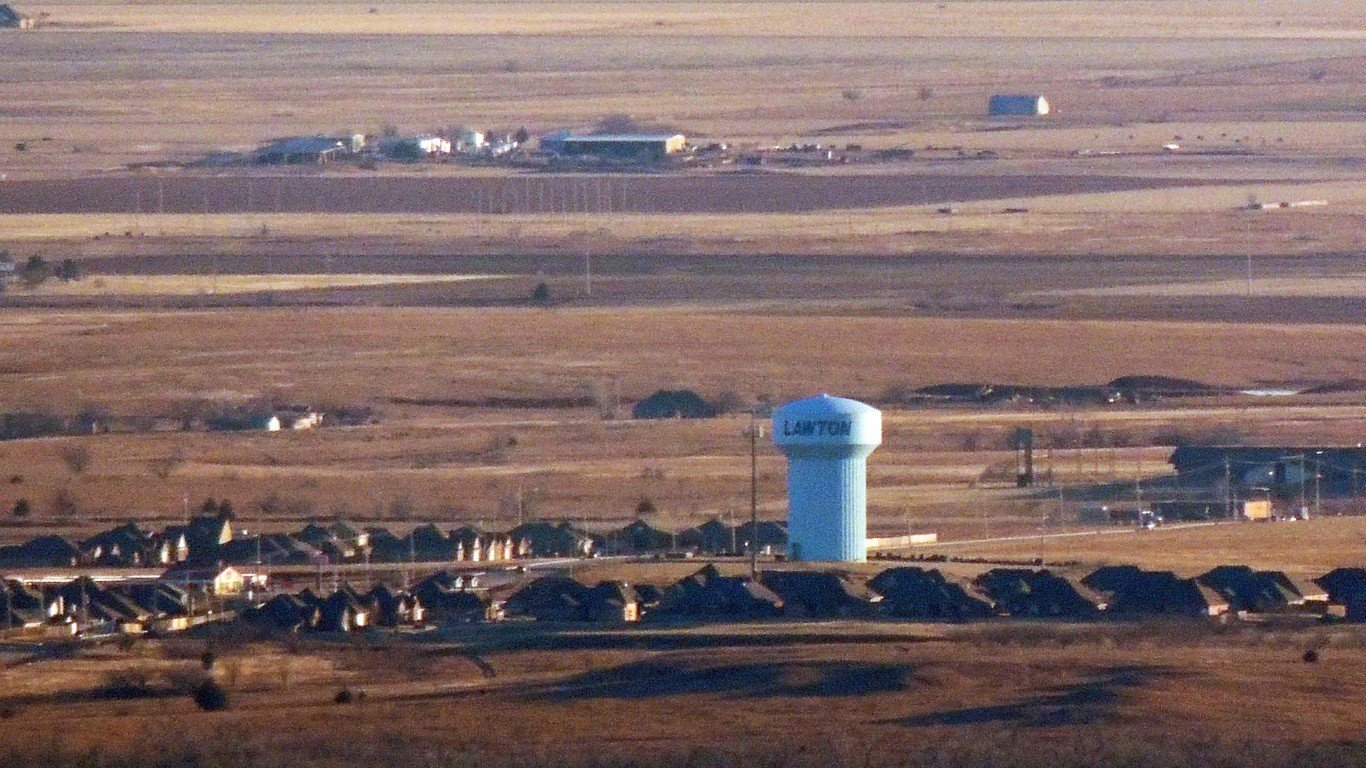
4. Lawton, OK
> Preschool enrollment: 38.7%
> High school graduation rate: 79.5%
> Pop. with access to areas for exercise: 42.5% (lowest 10%)
> Violent crime rate: 627.8 per 100,000 (highest 20%)
Children in Lawton, Oklahoma tend to lag behind the rest of the country in key educational measures. The 79.5% graduation rate is one of the lower percentages in the country, noticeably behind the 84.1% average among metro areas. There are also a relatively low share of Lawton three- and four-year-olds in preschool at 38.7%. Nationally, 48.0% of children that age go to preschool.
A lack of places for exercise out can contribute to a higher obesity rate, leading to a number of serious health problems later in life for children. Just 42.5% of Lawton, Oklahoma residents reported having a place to get physical activity, making it one of the ten worst places in the nation for exercise accessibility.
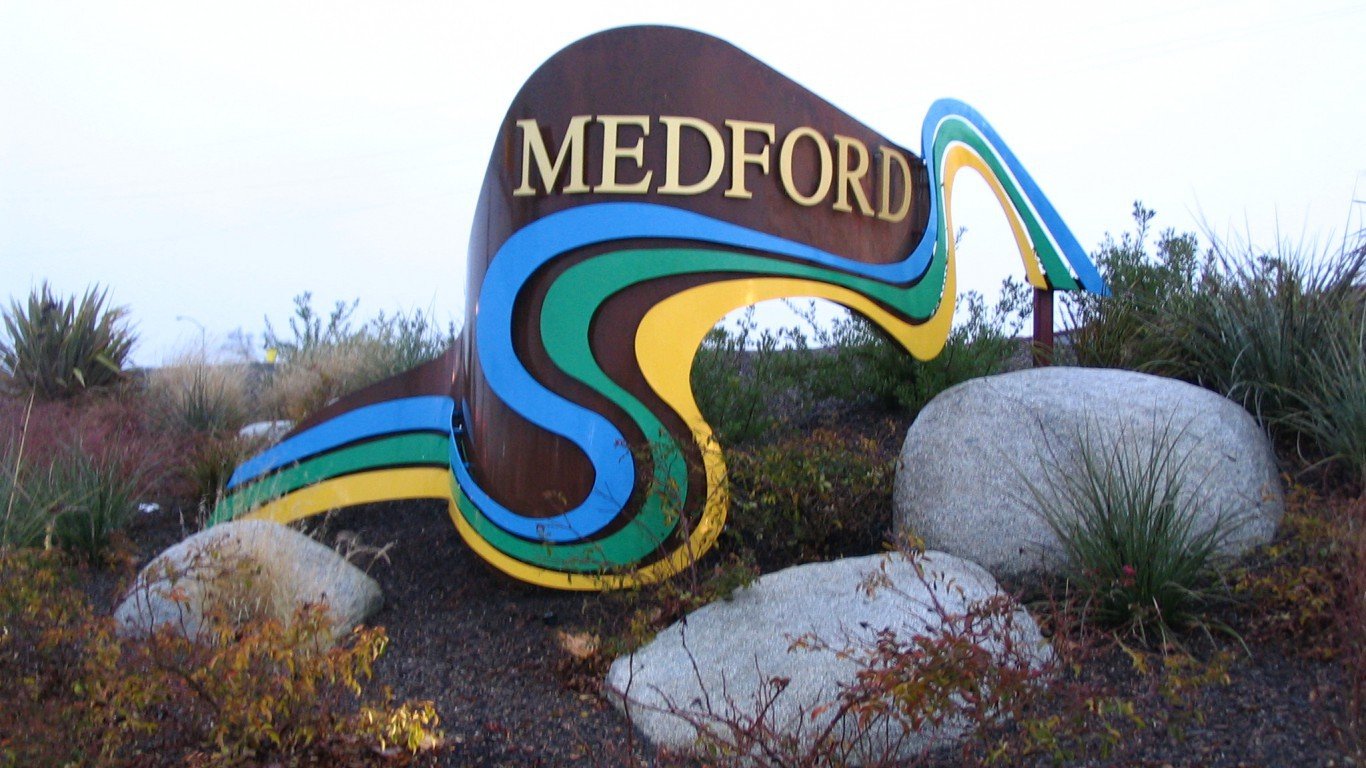
3. Medford, OR
> Preschool enrollment: 34.5% (lowest 20%)
> High school graduation rate: 75.0% (lowest 10%)
> Pop. with access to areas for exercise: 36.7% (lowest 10%)
> Violent crime rate: 357.8 per 100,000
One out of every four Medford, Oregon area high school students failed to graduate high school on time. Only a handful of other metro areas have a lower high school graduation rate. Younger students in the area, ages three and four, are also among the least likely to be in school. Just 34.5% of preschool-aged children are enrolled in school — well below the 48.0% national average.
Though the violent crime rate in the Medford area is below the national average, it is among the most prone to theft. There were 3,524 thefts reported for every 100,000 residents, more than double the national average. Children can often feel unsettled by living in high crime areas, which can harm their emotional development.

2. Battle Creek, MI
> Preschool enrollment: 16.3% (lowest 10%)
> High school graduation rate: 74.9% (lowest 10%)
> Pop. with access to areas for exercise: 77.5%
> Violent crime rate: 746.7 per 100,000 (highest 10%)
Preschool attendance has been shown to improve academic preparedness in children and help cognitive development. Battle Creek, Michigan has a very low rate of three- and four-year-olds in preschool. The 16.3% preschool enrollment rate is nearly one-third the U.S. rate of 48.0%. Only two other metro areas have a lower preschool enrollment rate. The Battle Creek area’s median family income is $60,365, falling more than $10,000 short of the national median. Some 26.8% of Battle Creek children live in poverty, compared to 19.5% of children nationwide. Children who are raised in poverty tend to have lower educational attainment rates and less economic mobility.
[in-text-ad-2]
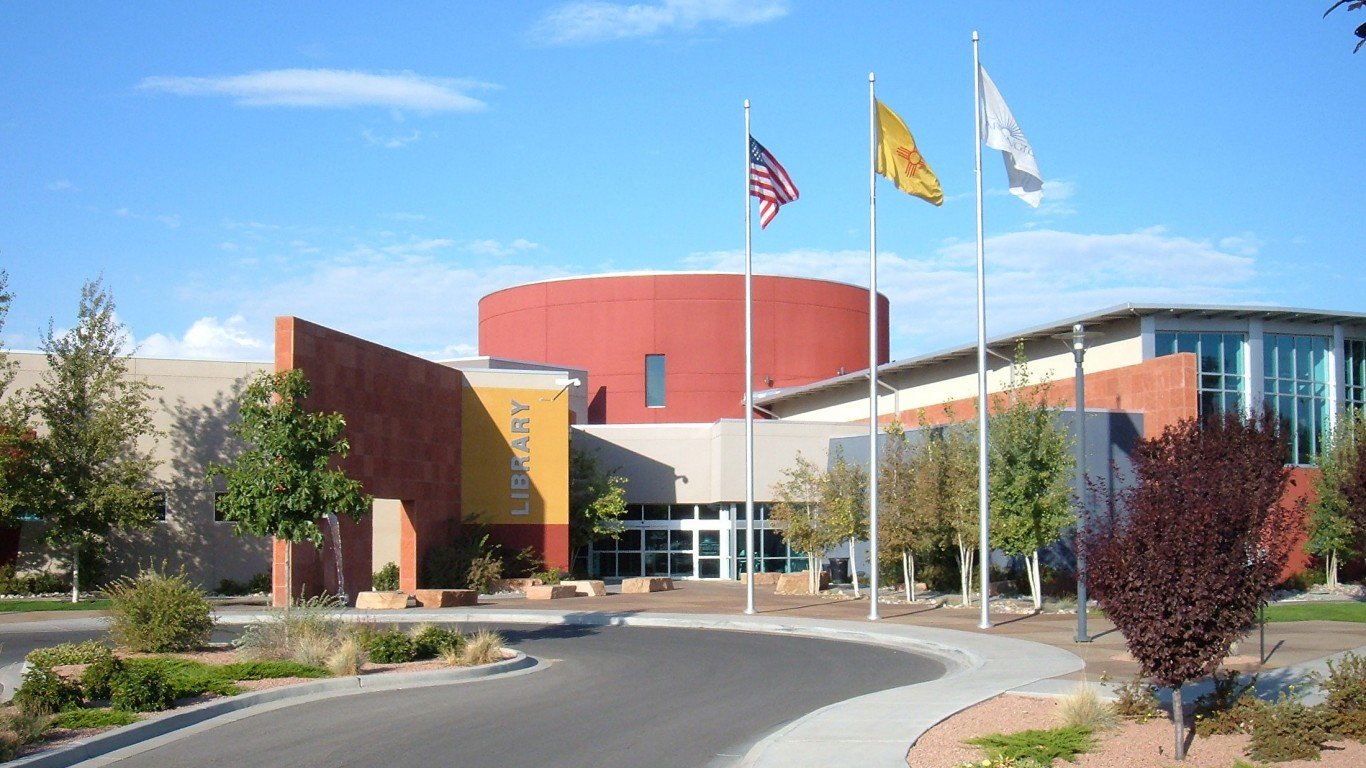
1. Farmington, NM
> Preschool enrollment: 47.0%
> High school graduation rate: 71.8% (lowest 10%)
> Pop. with access to areas for exercise: 52.5% (lowest 10%)
> Violent crime rate: 947.4 per 100,000 (highest 10%)
Farmington, New Mexico is the worst place in America to raise a child, as it is well below average in a number of key factors that determine what makes a place suitable for raising children. Farmington’s violent crime rate of 947 violent crimes reported per 100,000 residents is the fourth-highest in the country. The average community reports 368 violent crimes per 100,000 residents. The Farmington area’s high school graduation rate of 71.8% is also among the worst in the country. Among metro areas, the average graduation rate is 84.1%.
A small share of Farmington area residents, 52.5%, reported having a place to exercise. This lack of public spaces for exercise can indicate that there is a lack of monetary support for the community. The median family income of $63,973 is several thousand dollars below the national median. Some 25.5% of Farmington area children live in poverty, above the national child poverty rate of 19.5%.
Detailed findings & methodology:
Each of the components measured in our index — education, health, and safety — are important to the physical and cognitive development of children. A child’s development has been shown to greatly benefit by starting education with a preschool program. Children who complete their education and graduate from high school have greater economic mobility than those who do not. In addition to cognitive development, people also tend to develop healthy habits if they exercise in their youth. It is also important for a child to have a sense of security and well being — something that can be disrupted when a child is raised in a high-crime area.
When examining the harmful effects that suboptimal living areas can have on children, it can be difficult to isolate a single factor that makes an area a challenging place to raise children.
Ron Haskins, Co-Director of the Center on Children and Families within The Brookings Institution, said there is a “constellation of factors” that can make a neighborhood an undesirable place to raise children — including a high prevalence of poverty and crime and a lack of childcare.
Haskins said that, though these issues are less common than in decades past, they are “still perennial problems for low income parents, especially minority low income parents.”
The measures used to determine the worst places to raise children — crime, preschool enrollment, high school graduation, and exercise accessibility — are often inextricably linked, because the conditions that lead to them, including poverty and low adult educational attainment, are shared between all of these issues. Of the 25 places on this list, 22 have an above average crime rate, 23 have a below average preschool enrollment rate, 24 are less likely to have a place to exercise than the average metro area, and 23 have a high school graduation rate below 84.1%, which is the average rate among metro areas.
To determine the worst cities to raise children, 24/7 Wall St. ranked metropolitan statistical areas based on an index consisting of high school graduation rate, preschool enrollment rate among 3- and 4-year-olds, violent crime rate, and the percentage of a population with access to places for physical activity. The share of 3- and 4-year olds enrolled in preschool came from the 2016 American Community Survey from the U.S. Census Bureau. Violent crime rates came from the FBI’s 2016 Uniform Crime Report. Graduation rates and the share of the population with access to places for physical activity came from the 2018 County Health Rankings & Roadmaps, a Robert Wood Johnson Foundation and University of Wisconsin Population Health Institute joint program.
Take This Retirement Quiz To Get Matched With An Advisor Now (Sponsored)
Are you ready for retirement? Planning for retirement can be overwhelming, that’s why it could be a good idea to speak to a fiduciary financial advisor about your goals today.
Start by taking this retirement quiz right here from SmartAsset that will match you with up to 3 financial advisors that serve your area and beyond in 5 minutes. Smart Asset is now matching over 50,000 people a month.
Click here now to get started.
Thank you for reading! Have some feedback for us?
Contact the 24/7 Wall St. editorial team.
 24/7 Wall St.
24/7 Wall St. 24/7 Wall St.
24/7 Wall St.
